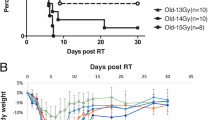Abstract
The number and spatial distribution of necrotic cells in the jejunal crypts of mice, has been measured after treatment by each of 6 cytotoxic drugs. At the LD10/8 day dose of each drug, the majority of necrotic cells were found below position 9 and numbers per crypt were similar for all drugs (approximately 8). These findings resemble those for radiation. However, major differences between agents were found in the calculated numbers of the microcolony-forming units (MFU) that determine overall crypt survival or ablation after high doses of cytotoxic agent. Numbers of MFU as assayed by radiation were approximately 80 per crypt, but only 2 when assayed by mechlorethamine hydrochloride, adriamycin and 5-fluorouracil, and 7 using BCNU. No crypts were destroyed by either cyclophosphamide or actinomycin D, despite the appearance of numerous necrotic cells in the lower part of the crypt. We conclude that in drug-treated intestine, necrotic cells may arise from a non-MFU compartment and the incidence and distributions of such cells are likely to be poor indicators of the response of the MFU.
Similar content being viewed by others
Rights and permissions
About this article
Cite this article
Moore, J. Death of intestinal crypts and of their constituent cells after treatment by chemotherapeutic drugs. Br J Cancer 49, 25–32 (1984). https://doi.org/10.1038/bjc.1984.5
Issue Date:
DOI: https://doi.org/10.1038/bjc.1984.5
- Springer Nature Limited
This article is cited by
-
Estimates of the number of clonogenic cells in crypts of murine small intestine
Virchows Archiv B Cell Pathology Including Molecular Pathology (1987)



